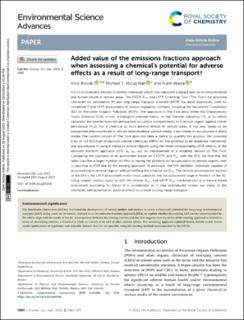| dc.contributor.author | Breivik, Knut | |
| dc.contributor.author | McLachlan, Michael S. | |
| dc.contributor.author | Wania, Frank | |
| dc.date.accessioned | 2023-10-16T13:21:26Z | |
| dc.date.available | 2023-10-16T13:21:26Z | |
| dc.date.created | 2023-09-22T12:48:35Z | |
| dc.date.issued | 2023 | |
| dc.identifier.citation | Environmental Science: Advances. 2023, 2, 1360-1371. | en_US |
| dc.identifier.issn | 2754-7000 | |
| dc.identifier.uri | https://hdl.handle.net/11250/3096776 | |
| dc.description.abstract | It is of considerable interest to identify chemicals which may represent a hazard and risk to environmental and human health in remote areas. The OECD POV and LRTP Screening Tool (“The Tool”) for assessing chemicals for persistence (P) and long-range transport potential (LRTP) has been extensively used for combined P and LRTP assessments in various regulatory contexts, including the Stockholm Convention (SC) on Persistent Organic Pollutants (POPs). The approach in The Tool plots either the Characteristic Travel Distance (CTD, in km), a transport-oriented metric, or the Transfer Efficiency (TE, in %), which calculates the transfer from the atmosphere to surface compartments in a remote region, against overall persistence (POV). For a chemical to elicit adverse effects in remote areas, it not only needs to be transported and transferred to remote environmental surface media, it also needs to accumulate in these media. The current version of The Tool does not have a metric to quantify this process. We screened a list of >12 000 high production volume chemicals (HPVs) for the potential to be dispersed, transferred, and accumulate in surface media in remote regions using the three corresponding LRTP metrics of the emission fractions approach (EFA; ϕ1, ϕ2, ϕ3), as implemented in a modified version of The Tool. Comparing the outcome of an assessment based on CTD/TE and POV with the EFA, we find that the latter classifies a larger number of HPVs as having the potential for accumulation in remote regions than is classified as POP-like by the existing approach. In particular, the EFA identifies chemicals capable of accumulating in remote regions without fulfilling the criterion for POV. The remote accumulation fraction of the EFA is the LRTP assessment metric most suited for the risk assessment stage in Annex E of the SC. Using simpler metrics (such as half-life criteria, POV, and LRTP–POV combinations) in a hazard-based assessment according to Annex D is problematic as it may prematurely screen out many of the chemicals with potential for adverse effects as a result of long-range transport. | en_US |
| dc.language.iso | eng | en_US |
| dc.rights | Navngivelse-Ikkekommersiell 4.0 Internasjonal | * |
| dc.rights.uri | http://creativecommons.org/licenses/by-nc/4.0/deed.no | * |
| dc.title | Added value of the emissions fractions approach when assessing a chemical's potential for adverse effects as a result of long-range transport | en_US |
| dc.title.alternative | Added value of the emissions fractions approach when assessing a chemical's potential for adverse effects as a result of long-range transport | en_US |
| dc.type | Peer reviewed | en_US |
| dc.type | Journal article | en_US |
| dc.description.version | publishedVersion | en_US |
| dc.rights.holder | © 2023 The Author(s). Published by the Royal Society of Chemistry | en_US |
| dc.source.pagenumber | 1360-1371 | en_US |
| dc.source.volume | 2 | en_US |
| dc.source.journal | Environmental Science: Advances | en_US |
| dc.identifier.doi | 10.1039/d3va00189j | |
| dc.identifier.cristin | 2177925 | |
| dc.relation.project | Norges forskningsråd: 343110 | en_US |
| cristin.ispublished | true | |
| cristin.fulltext | original | |
| cristin.qualitycode | 1 | |

